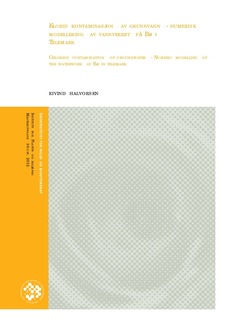| dc.description.abstract | Flere av Norges grunnvannsakviferer får tilført veisalt fra veier i nærområdet, slik at det kommer klorid og natrium i brønnvannet. Hensikten med masteroppgaven var å lage en metode for å
modellere transport av klorid i grunnvannsakviferer. En slik metodikk vil være til stor hjelp for å optimalisere veisalting, slik at tålegrenser for miljøet ikke overskrides. Oppgaven har som hypotese at vannbalansen er det viktigste elementet når det gjelder transport av klorid i grunnen. Verktøyet som brukes til numerisk modellering er COMSOL. I tillegg brukes GIS og MATLAB for å gjøre klar inndata til modellen. Modelleringen vektlegger vannbalansen i stor grad. Dette betyr at det er stort fokus på vannmengdene som kommer inn i modellen. Både ved infiltrasjon fra avrenning og infiltrasjon fra elv.
Strømmen av grunnvann modelleres stasjonært, mens transporten av kloridet modelleres over et tidsrom på 30 år. Modellen er todimensjonal.
Inndataene til modellen kommer fra nasjonale hydrologiske og geologiske databaser. Type inndata er avrenning, topografi, tykkelse på løsmasser, saltmengder fra vei, bakgrunnsverdier for salt i grunnvann og total pumperate for grunnvannsbrønnene. Et problem som ofte oppstår i numeriske modeller er numerisk dispersjon. Det var også tilfellet i
modellen i denne oppgaven. Numerisk dispersjon ble eliminert ved å regne ut kloridkonsentrasjonen med en alternativ metode, i tillegg til COMSOL sin løsning av transportligningen. Denne alternative
metoden regner ut kloridkonsentrasjonen i brønnvannet, ut fra forholdet mellom brønnens totale pumperate og saltmengden fra veien i brønnens nedslagsfelt. Sammenligning av simulerte og observerte kloridkonsentrasjoner i brønnvannet ved Bø vannverk, tyder på at metoden er ganske god. Differansen mellom simulerte og observerte kloridverdier er liten. Det ser også ut som mengden vann i modellen har størst innvirkning på kloridkonsentrasjonen i
brønnvannet. Mye vann i modellen fører til lavere konsentrasjon av klorid i brønnvannet på grunn av
fortynning. Dermed er minimering av usikkerheten rundt vannmengden som infiltrerer modellen veldig viktig. Several of Norways groundwater aquifers receive roadsalt from roads nearby, leading to chloride and sodium in the water in the wells. The purpose of the master thesis was to construct a method for numeric modeling of transport of chloride, in groundwater aquifers. Such a method will be valuable in optimizing appliance of road salt, so that critical loads for the environment are not exceeded. The thesis has as a hypothesis that the waterbalance is the most important element when it comes to transport of chloride in an aquifer.
COMSOL is used for numeric modeling. I addition, GIS and MATLAB are used for processing data, before COMSOL can import them. The model emphasizes the waterbalance. This means that there is focus on the amounts of water
that infiltrates the model. The water comes from runoff and from river infiltration. The groundwater flow is modeled in a stationary study, while the transport of chloride is modeled in a time dependant study, over a period of 30 years. The model is two dimensional. The models indata come from national hydrological and geological databases. Types of indata are
runoff, topography, thickness of sediments, amounts of salt applied to road, background levels of salt in groundwater and the total pumping rates of the wells. Numeric dispersion is often a problem in numeric models. This was also the case in the model in this master thesis. The numeric dispersion was however eliminated by calculating the chloride concentration with an alternative method, in additions to COMSOL’s solution of the transport
equation. This alternative method calculates the chloride concentration from the relationship between the wells total pumping rate and the total salt amount from the road in the wells catchment. Comparing the simulated and observed chloride concentration in the wells water imply that the method is good. The differences between the simulated and observed chloride concentrations are
small. It also seems that the amount of water, in the model, has the largest impact on the wells chloride concentration. Large amounts of water lead to smaller concentrations of chloride in the well because of dilution. This means, the uncertainty in the water amount infiltrating the model should be minimized as much as possible. | no_NO |
